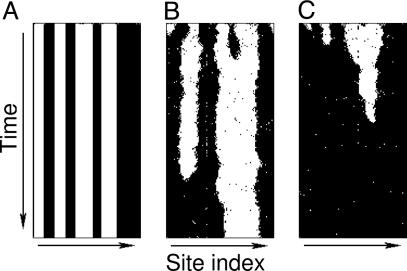Fig. 3.
Effect of noise intensity η and rewiring probability p on the time evolution of a system of CA operating according to the majority rule. We consider three systems comprising N = 99 and starting from the same initial configuration. As for the GKL rule, k = 6. (A) p = 0.05 and η = 0. The small-world topology alone has little effect on the evolution of the system, which rapidly converges to a configuration of stable domains of alternating states, similar to what is expected for a one-dimensional lattice. (B) p = 0.05 and η = 0.1. In this case, the noise destabilizes the boundaries of the domains. However, with only a few long-range connections, the system evolves slowly and some of the domains persist until the end of the simulation. (C) p = 0.1 and η = 0.1. In this case, the larger value of p enables local information to spread quickly, and all units rapidly evolve to a consensus.

